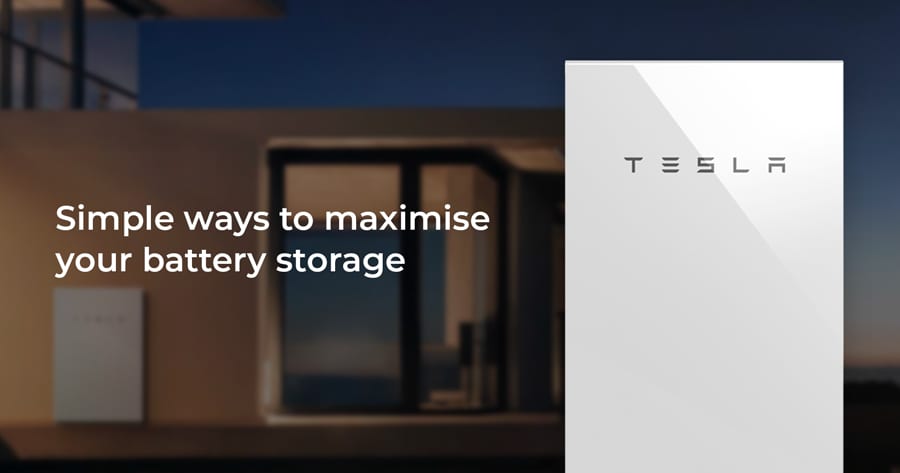Simple ways to maximise your battery storage

Battery storage can be a great addition to your solar PV system, as it allows you to store excess energy generated during the day to use at night when your solar panels stop producing energy, enabling you to reduce your reliance on energy bought from the grid.
In many states in Australia, there is still limited government support for batteries in terms of rebates and financial assistance, so the cost of incorporating batteries into your solar PV system may be high compared to the cost of the solar PV system itself. This is why if you do choose to invest in battery storage, you should make sure you are getting the most bang for your buck!
There are a few different ways you can ensure you are making the most of your battery, which will help you to save money both now and into the future.
Look at your energy usage patterns
Self-consuming the power that your solar system generates during the day rather than feeding it into the grid will ultimately save you money. To explain; a solar feed-in tariff (FiT) is a credit you receive for excess solar power that your system generates and exports back to the grid. Standard feed-in tariffs are typically between 3 - 15c per kilowatt-hour (kWh) but the rates vary in each state depending on government rebate initiatives and are ultimately determined by your electricity retailer.
In most states, though the feed-in tariff that you receive is substantially less than the cost you pay per kWh to your electricity provider for grid energy. For example, let’s say you pay 25c per kilowatt-hour (kWh) for grid electricity on a flat rate tariff. Every time you use 1kWh of solar energy by running your appliances during the day, you save 25c, but if you feed unused power your solar system generates back into the grid, you are only earning between 3 and 15 cents. Based on these example figures, you’re losing 10-22 cents of potential savings for every kWh of solar that you send to the grid.
The obvious factor here is that you must use the solar energy as it is being produced. This means that shifting some of your electricity usages to the daylight hours is the best way to save the most money with your solar panels, for example using the delay functions to run your dishwasher and washing during the day while you are at work. Unfortunately, this isn’t always possible, so this is where battery storage comes in handy!
Charge your batteries “for free”
When the sun is shining, your solar panels should be producing energy for your home to use. Unfortunately, if you aren’t home to use it all up, it would usually be sold back to the grid but with battery storage, you can store the excess power that your solar panels generated to use at night which will reduce the amount of money you need to pay for electricity from the grid.
Energy tariff arbitrage and Time of Use billing arrangements
Energy tariff arbitrage combined with a time of use (TOU) billing arrangement is a great way to ensure maximum money-saving benefits for your battery. It essentially means that you are charging up your battery with cheap ‘off-peak’ electricity for use later during peak times, when grid energy can be more expensive.
This works best with a TOU billing arrangement, as you pay less for power during times that are classed as “off-peak” and more for “shoulder” periods and the most for “peak” periods. With some clever planning, you can use your battery to buy your power when it is the cheapest, which can sometimes save even more money than self-consuming your power. For a more detailed explanation of how this process works, click here.
Emergency blackout backup power
This is probably one of the most useful features that come to mind when people think of battery storage – we all know how frustrating and inconvenient it can be when your power goes out, so how great would it be to be able to get your power from your battery during a blackout?
While this is a great feature of many batteries, not all are equipped to continually provide power during a black-out. For safety, many batteries are connected to the grid in a way that if supply to the grid is cut you will, unfortunately, not be able to access power from your battery.
If you are able to benefit from backup functionality in your solar and battery system, you will need to be mindful of how much energy you consume while the power is out, as your resources will be limited. Turning off and unplugging unnecessary devices throughout your home as soon as the power goes down could significantly extend the amount of time you can keep things running without the grid, enabling you to make the most of your battery as a backup power supply.
If blackouts are common in your area, or if you live in a rural area where electricity supply isn’t always consistent, then speak to your solar provider about your options for batteries that can provide power during grid interruptions and blackouts, as it is a huge benefit for those that cannot or don’t want to have to rely on back-up generators.
With a little careful planning and paying attention to your energy consumption, you can easily ensure you are making the most of your battery.
To learn more about batteries, get an obligation-free quote for a solar and battery system, or to find out if battery storage can be integrated into your existing solar PV system, contact us today on 1300 074 669.


